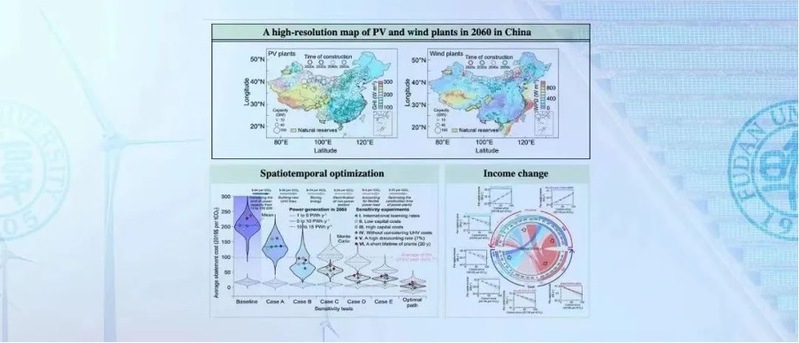China aims to peak carbon dioxide emissions by 2030 and achieve carbon neutrality by 2060. To achieve this goal, China should replace high-polluting fossil fuels with clean renewable energy as soon as possible. Despite the falling costs of solar and wind in the past decade, it is of significance to know whether solar and wind energy will be limitless under the growing demand for energy. Investigating the maximal capacity of renewable energy and seeking a scientific and reasonable pathway for decarbonizing the energy systems deserve urgent research.

Against this backdrop, on July 26, the world’s leading science journal Nature published a research paper entitled “Accelerating the energy transition towards photovoltaic and wind in China” by the international team led by Wang Rong from Department of Environmental Science and Engineering and IRDR-ICoE-RIG-WECEIPHE, Fudan University. In this paper, an optimisation framework that considered geospatial capacities for installing new photovoltaic panels and wind turbines, expansion of existing ultra-high-voltage transmission, storing energy, flexible power loads, and the dynamics of learning has been raised.
Based on the high-resolution distribution of solar and wind energy resources, this study proposed a low-cost, high-efficiency energy transition pathway, which produces a possibility to significantly reduce the costs needed to achieve the goal of 2060 carbon neutrality in China. In addition, the study highlights the need for policy intervention to upgrade power systems, as well as the co-benefits in increasing resident incomes.
Due to limited cheap clean energy, cost of clean energy in the future maybe not super low. To achieve the ambitious goal of 2060 carbon neutrality, Chinese government needs to increase investment in clean energy, optimize power loads and strengthen construction of coordinating facilities such as the long-range ultra-high-voltage transmission lines and hydro pump power stations. The study indicates the optimal path for China to accelerate the growth of photovoltaic and wind power to achieve the goal of carbon neutrality.
However, due to the difficulties in technological advances and construction duration, the next decade will be crucial for China to achieve the proposed capacities of photovoltaic and wind power by 2060. Optimizing the temporal planning of construction and layout of national clean energy development strategies can avoid greater economic costs in the middle of this century. In addition, after upgrading the national power system to fit the hourly power generation by photovoltaic and wind energy, the transmission of photovoltaic and wind power will lead to tremendous cross-regional financial flows, which can increase income for residents living in the western areas, reduce poverty and provide impetus for the national economic growth.
Link to the paper: https://doi.org/10.1038/s41586-023-06180-8
END
Presented by Fudan University Media Center
Source: Department of Environmental Science and Engineering
Editor: Wang Mengqi, Li Yijie





